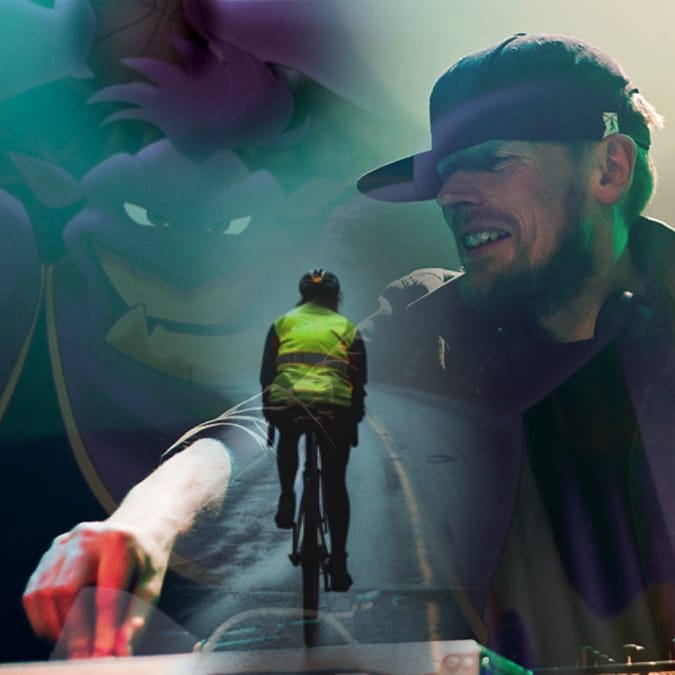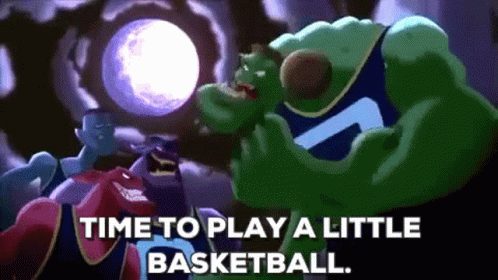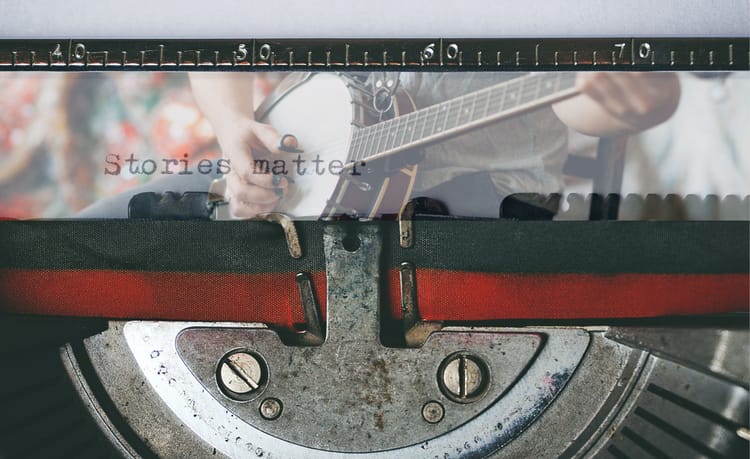We're All Jocks, Jamming

The music clicks on. It pumps through wires, pulses from speakers, pounding to the beat of your blood.
You ready for this?
Music rolls out across the court, techno-beats over the shiny hardpack plastic, dancing over the squeak of shoe-soles, the thundering echo of the ball, the acrid scent of sweat and exertion.
You ready for this?
Music echoes over green turf and gridiron, through the too-bright lights that carve through the night, martial music, fighting music, scoring every score, every shoulder tackle, every collision and kick. Music of the spheres, of the oblong pigskin, of the stretched legs and grinning teeth. Music for movement. Music that repeats a single, looping question.
You ready for this?
Welcome to Heat Death, the newsletter that knows when it's time to sweat. It's been a hectic time here at the various Casas Elbein. Saul's been busy at The Hill covering the aftermath of the ruinous flooding in the Texas Hill Country last month, as well as imminent redistricting in Texas and Trump's apparent efforts to handicap disaster preparedness. He's been even more busy expecting the imminent arrival of his second child. (Mazel tovs all around, please.) Asher has been juggling book writing and paying work, including making a long dreamed of debut in National Geographic, writing about a deeply weird little Triassic reptile.
We've got something a little different for you today: a piece by Stephen Lurie touching on the world of sports and music, and how two things we now think of as basically inseparable first got entangled. It's a story that begins with the bizarre blockbuster Space Jam, threads through a series of smash mashup albums, and follows a transition that's been so total that it's hard, now, to recognize that it happened at all. And – in a nice marriage of form and content – it will be delivered in mixtape form.
You ready for this?
It's Heat Death. Stay with us.
Prelude: Let's Get Ready To Rumble
Stephen here. Let’s say you are an alien, perhaps even a Monstar: a creature sent to earth to steal the prowess of this planet’s athletes, just like your forebears leeching NBA talent in order to take on a team of Michael Jordan, some cartoons, and the actor William Murray. You’ve grown up on that epic story, recorded in the Earthling cult-classic Space Jam. Now you’ve come back for another go.
But what’s this? Now instead of an echoey hardwood court of the 1990s, you’ve landed in 2025. The place where the athletes all hang out now seems to be …a music venue?! Ceiling speakers pump out a relentless playlist of singy-songy bops. In the mirror-walled rooms — rectangles laid out mysteriously on the floor — echo setlists of much faster, boom-ier tracks. Darkened chambers where people ride stationary machines feature tightly constructed flows of up and down tempo songs. In other spaces, guests flipping tires and swinging ropes have brought their own portable speakers to DJ their own individual dances.
And as if the clashing music from every speaker weren’t enough — almost everyone else here has wireless headphones in, even the ones swimming underwater. Plucking a pair off a concert-goer, you find that they were listening to their own bespoke playlist (“Sam’s Swole Mix”??)
No, wait — despite all that music, because of all of that different music, it is clear that this is no concert. There are athletes here: riding bikes fixed to the ground, moving around heavy objects, doing what you recognize as Zumba (popular in other galaxies, too). Others, more comfortingly, are playing your beloved basketball.
Unnerved nonetheless, you grab the nearest struggling gym-goers and head for home, the sound of jocks jamming ringing in your ears.
Track 2: “Get Ready For This”
But if you hadn’t fled so quickly from this new Earth, you’d find that the centrality of music at that gym is just one expression of a historically novel shift – one that's fused music and exercise, song and sport, transforming our expectations for the sound of movement.
What happened in between your predecessors’ visit and now? Well, here’s one thing: The release of a series of successful compilation albums called “Jock Jams,” made up of songs related — some more tenuously than others — to sports. But also: a series of technological and cultural transformations that, in just a Millennial’s lifetime, has produced far-ranging effects on our societies, bodies, and minds.
As an album, Jock Jams itself may (perhaps) not be solely responsible for that shift. But “jock jams” as a concept — combined with new abilities to bring personalized music into every context of human life — has changed the way we exercise and even how we think.
Track 3: Whoomp! (There It Is)
Thirty years ago this month, ESPN collaborated with Tommy Boy Records to release Jock Jams, Volume I, a compilation of previously-released pop, electronic, and hip-hop tracks complemented by interstitial audio clips cut from broadcasts and sporting events.
What all these sounds had in common was either a pre-existing association with sports, or the lyrical content or rousing energy that could suggest one. That concept could have been slapdash, but Jock Jams plays seamlessly as a DJ set from front to back. The album codified the idea of a “jock jam” as both a sports song and a song for sports, and was followed swiftly by three more volumes – Jock Jams Vol. 4, in 1998, would have the Quad City DJ’s “Space Jam” as track 5 – all of which finished their release year in the Billboard 200.
In bringing music and sports together, the album was both riding a cultural wave that had been building in the preceding decade — and, by riding it, labeled it as a swell worth getting on.
No single piece of art changes the culture, because the culture has always already been brought to the moment of change by innumerable small shifts — the little waves that create the big one. But comparing our era to the one before Jock Jams, reminds us of the unprecedented dynamic we hear and feel now, one where music serves sports, and in turn, also becomes a product of sport.
Track 4: Strike It Up
Music has accompanied sports-as-entertainment in some way for thousands of years — lyres at the Olympics, drums during Aztec ball games, marching bands at the gridiron. But the release of Jock Jams, Volume 1 coincided with a new inflection point: an unprecedented fusion of professional sports and music, whose relationship had been fairly stagnant in the modern era.
Up until the 1990s, in fact, sports had been a surprisingly silent affair. While parks hosting Major League Baseball teams had organs since 1941, and “walk up songs” started accompanying specific players in the 1970s, clubs started innovating with recorded music only in the early 1990s. Teams were upgrading their sound systems to enable clear recorded music of all kinds to be piped throughout their stadiums. Within a few years of the first pre-recorded walk-up song, the practice had become almost universal throughout the league – just as those new sound systems were put to more and more uses.
Today, the entire event of a Major League Baseball game is soundtracked. At a recent New York Mets game, the national anthem gave way to a mash up “Get Your Freak On” and “Wonder Wall,” followed immediately by a synth track for the Braves lineup, a hip-hop beat for the Mets Lineup, a remix of “Gasolina” that flowed into “Mundian te Bach Ki” and a Michael Jackson medley while the teams walked on, interstitial tracks in the top of the inning, all the way up to the clip of The Temptations’ “My Girl” as Francisco Lindor walked up to the plate for the Mets’ first at-bat.
This is now typical of American sports stadiums. The Miami Heat hired its first full time team DJ in 1999; every NBA team now has a DJ, who plays music during timeouts and other breaks – as well as during parts of play. The music is considered such a part of “home court advantage” that, in 2020, during the playoffs for the NBA bubble season held in Florida, the league had to issue regulations that DJs could only play songs associated with teams designated as the “home” team during those games. Both WNBA and NBA teams would only get their home court audio played when they were listed first on the scoresheet, regardless of the fact that all the teams were stuck in Orlando. In the NFL, stadiums aren’t the only ones that have their own DJs: NFL teams have also started a practice of choosing “practice DJs”, members of the team’s staff designated to soundtrack team practices.
At any of these events, the general rule is that whenever the ball isn’t in play, every second is soundtracked by the venue — snippets of actual canonical cuts from the Jock Jams albums, adopted “jock jams,” popular songs of the moment, and singalong-ready oldies. On top of filler music, teams and stadiums have developed fan favorite songs that the venue cues up for a particular reason — “Bang on the Drum All Day” for a Green Bay Packers touchdown — or just at a customary time, like Blink 182’s “All the Small Things” in the third period of Colorado Avalanche home games.
But the connection between sporting excellence and music didn’t just grow inside the stadium. The democratization of video production and editing also made the documentation of sports another forum for music. That’s apparent in any highlight reel one can find cut together today on Youtube – 50 Messi Skills that Stopped the Internet, Best Throws in NFL History, or even the 10 CRAZIEST Badminton Rallies of 2021-22— but it’s also a central dynamic in the late 1990s transition to consumer-ready video recording.
Skateboarding videos in particular, like 1997’s Zoo York Mixtape, helped fuse music into the identity of a sport itself. As Kevin Lozano writes at Pitchfork — documenting “The 10 Best Soundtracks from Skateboarding Videos”— the music was an “inextricable” part of compilation “that orchestrated the assorted feats of physical impossibility.”
Whether it was the celebrities of the most popular sports in America or emerging heroes of a subculture, beginning in earnest in the mid-1990s, fans were trained to see their greatest feats, live or recorded, suffused with music.
Track 10: Gonna Make You Sweat (Everybody Dance Now)
While new feats of commercial and recording technology were connecting music to professional sports, advances in personal audio technology finally enabled average people to move to a beat in any way they wanted — unencumbered by outlets, wires, or skipping discs. Although the Walkman advertised movement (it’s right there in the name), the Jock Jams era made music available to any kind of physical exertion with essentially zero weight or mobility restriction.
The key revolution allowing this was the MP3 format, which was introduced in 1992. Beginning in the late 1990s, MP3 and other kinds of portable, nearly weightless media players — whose non-mechanical solid state hardware means that movement doesn’t affect playback — made it possible to play music while running, jumping, biking, and lifting. Savvy athletes just needed to discreetly tuck those headphone cords.
When Bluetooth technology arrived in 1999 — and was paired with headphones for music by 2004 — listeners were allowed even more freedom. By 2020, one third of headphone use was wireless — a rate that doubled in the next four years. Today, the combination of compact music storage, bluetooth connectivity, and bone conduction technology has enabled athletes to take music everywhere: in any kind of exertion, in the gym, on the road, trail, or under water.
And though a gym or loop around a park might feature hundreds of simultaneous music experiences, the change has also been communal. While people have carried portable radios and boomboxes to basketball courts and sports fields since far before Jock Jams, portable bluetooth speakers – a market that has doubled since 2018 and is expected to double again by 2030 – have made it easier than ever to DJ team sports, too. Where it once required costly renovations to bring recorded music to stadiums, it became cheap and easy for average people to bring audio to their own arenas. The combination has been democratized: now any volleyball game at the beach, touch football at the school field, or pick-up game at the park can have its own Jock Jams-style accompaniment, too.
Track 13: The Power
But all that new hardware wasn’t enough to drive the fusion of jocks and jams: the music industry had to change too. Albums aren’t built for leg day, and artists aren’t writing all their music to BPMs for a casual run pace. Shortly after the release of Jock Jams, the music industry broke into our current era of song-centered listening. In less than a decade, listeners were granted access to an endless library of individual tracks in place of the individual, costly jewel-cased CDs that preceded them. Beginning around 2000, this new era allowed for anyone to make thematic compilations (“playlists”) — the country’s biggest sports media company and a record label not required. In essence, the number of unofficial Jock Jams volumes are now in the millions.
The evolution of a track-based music industry through the periods marked by Napster (1999), iTunes (2001), and Spotify (2006), enabled users to organize music around any particular energy – dinner parties, studying, road trips, and, of course, exercise. Today, people can make their own workout playlists and can even more easily find music served to them for whatever experience they’re looking to have. Spotify has official playlists for every type of workout: 80s Workout, Throwback Workout, Classic Rock Workout, Gym Beats, Pumped Pop, Workout Twerkout, Beast Mode — besides the custom ones pre-built from your library. Runners can choose a BPM playlist that matches their desired pace, or use the apps RockMyRun, Nike Run Club, or Pace DJ for a boutique music-exercise experience.
This connection has also been institutionalized in workout classes and platforms. Peloton instructors are known for their playlists and Peloton corporate employs a “Producer of Music Programming”; SoulCycle has a partnership with Apple Music. OrangeTheory specifically centers music in their brand, saying “[o]ur music is specifically curated to our workouts — it’s not just background noise, it’s a motivator for members to push themselves further and keep coming back.” While certain kinds of exercise classes had been set to music since the 1960s, it had largely been restricted to dance fitness. Today, few, if any, kinds of workout – even yoga or pilates — lack music.
Track 15: Unbelievable
But it’s not just the jocks. For those that prefer the privacy of their own home — or the couch over the bench — the association between music and athletics has been reinforced through our virtual worlds. In the same mid-1990s period when technology was starting to make music more accessible to actual sports, it also became technically possible to put complex compositions in video games, where earlier hardware could only accommodate simple tones or low quality audio. Sports video games – mimicking real people and places, instead of fictional ones like many other games — made sense as a venue for real world music, too.
FIFA 98 was the first of that franchise to license music for its soundtrack — putting “Song 2” by Blur as its opening track. The soundtrack is now a perennial point of discussion for the game’s fanbase — as is the question of what constitutes the best sports video game soundtracks more broadly. At the same time, video game advances beyond sound processing also produced a series of games that made music itself into sport, exercise, or competition. From Dance Dance Revolution (1998 in Japan, 1999 North America), through Guitar Hero (2005) and Rock Band (2007), and Beatsaber (2019), our games have fortified this relationship from the other direction: wherever there is music, there might also be sport.
Track 18: Twilight Zone
Since we don’t have an alternate, cartoon universe to compare it to, the full impact of this transformation on our culture and sports is hard to gauge. But what we do know about the effect of music on performance – as well as the operation of our brains generally – suggest that the world after Jock Jams is quite different from the one before.
There are the obvious social effects, which point in different directions: music where there would have been silence or conversation, yes, but also collective singing where there could have been isolation. Stadium fandom involves a lot more dancing than you might otherwise expect or find aesthetically, uh, good.
But most curiously, and hardly noted: the athletic effect of all this music is likely profound. There’s no doubt that music has made us better at sports, particularly professional sports. Music can reduce your perception of fatigue, increase arousal and neural activity in ways that improve performance, and produce synchronization that increases efficiency. Studies suggest music — and particularly music that is familiar or you like — can not only make you feel better, but, via methods like increasing oxygen consumption, actually make you perform better.
Together, science suggests that curated sounds can improve the training process; hometown songs can contribute to home team victories. At a global level, it’s reasonable to suggest that the application of music to sports is at least one of the factors responsible for the continued achievement of world records and first-time-in-league-histories.
It’s also likely, however, that these athletic advances come at a cognitive cost. The proliferation of music cuts into the parts of our life where our brains could otherwise find relief. Precisely as music — particularly the “happy” music associated with exercise — enhances attention, it decreases our time for mind wandering, spontaneous thoughts unrelated to tasks-at-hand or external stimuli.
More than just distraction, that process is increasingly understood as crucial for creative thinking, problem solving, memory consolidation, and as a form of “wakeful rest.” Physical activity generally is understood to be important for inducing this kind of creative and divergent thinking; repetitive activities like distance running are particularly fruitful for mind wandering and its associated benefits. When we layer music onto these activities – plus the attentional task of looking at our phones to change songs – we’re increasing attention to stimuli and tasks that break our ability to follow those spontaneous lines of thinking. Harder, better, faster: yes. But also, perhaps, dumber.
In a sense, this cost is not unique to sports: it’s just one more expression of brain sacrifice to our screen-god of multitasking. (If you clicked on any of songs above, you may have had a more entertaining reading experience — at the risk of fully absorbing, or even finishing, the reading). Nonetheless, despite the fact that’s it’s now completely expected to listen to music as we move our bodies, the striking recency of this development should challenge that feeling of normalcy.
In other words: Run some days on empty brain. It’s okay to listen to your thoughts while you get your reps in. Everyone used to do it.
Other times? Go ahead, pump up the jam.
Stephen Lurie is a writer and strategist in Brooklyn. His writing and other projects can be found at stephenlurie.com; his miscellaneous thoughts at @luriethereal on all platforms, but particularly Bluesky.
This piece was supported by paid memberships to this newsletter. If you'd like to support us – and help us commission more work like this – please consider grabbing a subscription or leaving us a tip!
Want to pitch us? Send ideas to aelbein@gmail.com.
We'll be back soon with more musings on past, future, and all the crises in between. Till then – we'll see you on the court.




Member discussion